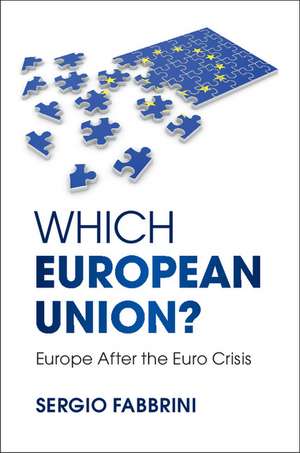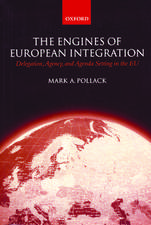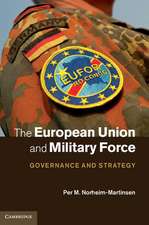Which European Union?: Europe after the Euro Crisis
Autor Sergio Fabbrinien Limba Engleză Paperback – 25 feb 2015
| Toate formatele și edițiile | Preț | Express |
|---|---|---|
| Paperback (1) | 254.16 lei 6-8 săpt. | |
| Cambridge University Press – 25 feb 2015 | 254.16 lei 6-8 săpt. | |
| Hardback (1) | 699.36 lei 6-8 săpt. | |
| Cambridge University Press – 25 feb 2015 | 699.36 lei 6-8 săpt. |
Preț: 254.16 lei
Nou
Puncte Express: 381
Preț estimativ în valută:
48.64€ • 50.65$ • 41.11£
48.64€ • 50.65$ • 41.11£
Carte tipărită la comandă
Livrare economică 10-24 martie
Preluare comenzi: 021 569.72.76
Specificații
ISBN-13: 9781107503977
ISBN-10: 1107503973
Pagini: 376
Ilustrații: 8 b/w illus. 19 tables
Dimensiuni: 152 x 229 x 20 mm
Greutate: 0.52 kg
Editura: Cambridge University Press
Colecția Cambridge University Press
Locul publicării:New York, United States
ISBN-10: 1107503973
Pagini: 376
Ilustrații: 8 b/w illus. 19 tables
Dimensiuni: 152 x 229 x 20 mm
Greutate: 0.52 kg
Editura: Cambridge University Press
Colecția Cambridge University Press
Locul publicării:New York, United States
Cuprins
Preface: how many Unions?; Part I. Institutionalisation of Multiple Unions: 1. From Rome to the Lisbon Treaty; 2. The Lisbon Treaty and the Euro Crisis; 3. Institutionalisation and constitutional divisions; Part II. Main Perspectives on the European Union: 4. The perspective of the economic community; 5. The perspective of intergovernmental union; 6. The perspective of parliamentary union; Part III. Towards the Compound Union Perspective: 7. Comparing democratic models; 8. Compound unions and the EU; 9. A new political order in Europe.
Recenzii
'Fabbrini brings to bear the skills of a seasoned analyst of comparative politics, a sophisticated knowledge of the federalism literature, and a deep familiarity with the workings of the EU. This book will surely animate a lively debate about where the EU has been and how it can develop in the future.' James A. Caporaso, University of Washington
'In this conceptually sophisticated and historically erudite study, Sergio Fabbrini offers a highly original reinterpretation of the European construct and the structural causes of its current crisis. Supported by outstanding scholarship, his vision of multiple but connected Unions as the best way to escape Europe's current conundrum is bound to become a critical referent in today's debates over the trajectory of the European project.' Kalypso Nicolaïdis, University of Oxford
'Which European Union? is a rare combination of truly comparative breadth and impressive analytic structure which make this book a 'must read' for those interested in the European Union. Its comparative focus on 'multiple separation of powers systems' identifies the EU as belonging to that group of political systems in which the government is a process rather than an institution. Fabbrini thereby suggests a new theoretical approach to explaining why the EU works as it does.' Alberta M. Sbragia, University of Pittsburgh
'The Eurozone needs further integration, not so the common market. A new plural architecture is needed to preserve the distinct features of the two main clusters of the EU and at the same time to give them a common framework. If we don't want to go back, the way forward suggested by this book deserves the highest attention.' Giuliano Amato, former Italian Prime Minister and Vice-President of the Brussels Constitutional Convention
'[Which European Union?] correctly puts an emphasis on the role of Sarkozy and Merkel in dealing with the crisis, while other EU actors were partially marginalised.' Davide Vittori, The International Spectator
'In this conceptually sophisticated and historically erudite study, Sergio Fabbrini offers a highly original reinterpretation of the European construct and the structural causes of its current crisis. Supported by outstanding scholarship, his vision of multiple but connected Unions as the best way to escape Europe's current conundrum is bound to become a critical referent in today's debates over the trajectory of the European project.' Kalypso Nicolaïdis, University of Oxford
'Which European Union? is a rare combination of truly comparative breadth and impressive analytic structure which make this book a 'must read' for those interested in the European Union. Its comparative focus on 'multiple separation of powers systems' identifies the EU as belonging to that group of political systems in which the government is a process rather than an institution. Fabbrini thereby suggests a new theoretical approach to explaining why the EU works as it does.' Alberta M. Sbragia, University of Pittsburgh
'The Eurozone needs further integration, not so the common market. A new plural architecture is needed to preserve the distinct features of the two main clusters of the EU and at the same time to give them a common framework. If we don't want to go back, the way forward suggested by this book deserves the highest attention.' Giuliano Amato, former Italian Prime Minister and Vice-President of the Brussels Constitutional Convention
'[Which European Union?] correctly puts an emphasis on the role of Sarkozy and Merkel in dealing with the crisis, while other EU actors were partially marginalised.' Davide Vittori, The International Spectator
Notă biografică
Descriere
This book asks how the European Union can tackle the constitutional conundrum caused by the Euro crisis.


















